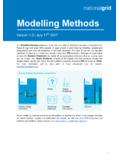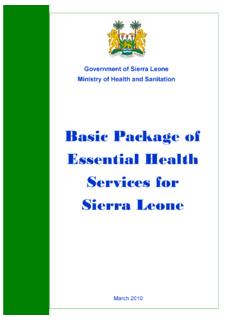Transcription of Maryland Medicaid Program: An Overview - prrac.org
1 1 Maryland Medicaid Program: An Overview Stacey DavisPlanning AdministrationDepartment of Health and Mental HygieneMay 22, 20072 Maryland Medicaid In Maryland , Medicaid is also called Medical Assistance or MA MA is a joint federal-state program that provides health and long term care coverage to low-income children and parents, pregnant women, the elderly, and people with disabilities MA provides three types of critical health protection: Health insurance for low-income families, children, the elderly, and people with disabilities Long-term care for older Americans and individuals with disabilities; and Supplemental coverage for low-income Medicare beneficiaries ( outpatient prescription drugs and payment of Medicare premiums, deductibles, and cost sharing3 Covered Populations Medicaid provides medical and long-term care coverage to low income Maryland citizens Medicaid covers three main groups Children and pregnant women The elderly Persons with disabilities The Maryland Children s Health Program (MCHP) provides health coverage to children in families with incomes below 200% of poverty (a monthly family premium is required for families between 200% and 300%).)
2 Pregnant women with incomes up to 250% of poverty are covered under Medicaid4 Services Covered Under Medicaid Medicaid and MCHP cover a broad range of health care services, including services mandated by the federal government as well as optional services that a state may choose to cover. Mandatory services include: Hospital care (inpatient and outpatient) Nursing home care Physician services Laboratory and x-ray services Immunizations and other early and periodic screening, diagnostic, & treatment (EPSDT) services Family planning services FQHCs and rural health clinic services Nurse midwife and nurse practitioner services5 Services Covered Under Medicaid Optional services include.
3 Prescription drugs Institutional care for individuals with mental retardation Home and community-based care for frail elderly, including case management Personal care and other community-based services for individuals with disabilities vision care for adults Services must be adequate in amount, duration and scope States may impose cost-sharing on some services (eg. drugs). Certain populations must be excluded from cost sharing6 HealthChoice and Maryland Children s Health Insurance Program (MCHP) HealthChoice (July 1997) MCHP (July 1998)MCHP Premium Expansion of children through 300% of the FPL (July 2001)Long-Term Care Home and Community-Based Waivers Medicaid waiver for Older Adults (January 2001) Waiver for Adults with Physical Disabilities (April 2001) Waiver for Children with Autism Spectrum Disorder (July 2001) Waiver for Adults with Traumatic Brain Injury (June 20, 2002)Other Breast and Cervical Cancer Treatment Program (April 2002)
4 Employed Individuals with Disabilities Program (April 2006) Primary Adult Care Program (July 2006) Medicaid Changes and Expansions 7 Medical Assistance Program Coverage(Effective 07/01/06)Note: This chart is for illustrative purposes only. Each coverage group has specific eligibility and some asset requirements, which are not 65 and Over+~ 22513510019610 Age 19 to 64250PW185 Poverty Level:1 person = $10,2102 persons =$13,6904 persons = $20,650As of 1/24/2007 MCHP Premium MCHPM edicaid Primary Adult Care Program 116% FPLHome and Community-Based Waivers(only for very specific populations)Pregnant WomenDual Eligible Medicare & MedicaidQMB-Premium & Cost Sharing SLMB Premium Individuals with Disabilities Program (EID) 300% FPL3008 Medicaid Enrollment In FY 2006, there were an average of 594,000 enrollees with full benefits Approx.
5 490,000 in Managed Care Organizations (MCOs) Remaining are in Fee-for-Service (FFS) Cost is ~$ ($ in MCO payments) About a third of enrollees are in optional categories Total enrollment is about 700,0009 Medicaid Funding Like other states, Maryland receives federal matching funds (although the amount varies from state to state) 50% federal matching for most Medicaid services 65% federal matching for the Maryland Children s Health Program (MCHP) 75% federal matching for some operational/systems initiatives 90% for Family Planning Program10 Medicaid Growth Rate Over the past several years, the average annual growth rate for Medicaid expenditures has been close to 9%per year (although trends have slowed in the most recent fiscal year) Pharmacy costs are growing at a rate of approximately 12%per year Long term care costs have grown at a rate of approximately 10%over the past several years Medicaid makes up an increasingly large portion of the State budget approximately 16% (general funds)
6 11 Medicaid Expenses by Enrollment = 594,300 Payments = $ BillionElderlyDisabledAdultChildExcludes data for individuals with partial benefits12 Service Delivery Under HealthChoicemanaged care, seven MCOs contract with DHMH to provide Medicaid covered services through their provider networks in return for monthly payments from DHMH. Some Medicaid services are not covered by the MCOs, and may be received through Medicaid fee-for-service (such as therapies for children). If the person does not qualify for HealthChoice( , because they are also Medicare eligible or in a long-term care facility), they will still receive Medicaid services, but through fee-for-service (FFS).
7 Specialty mental health services are provided by the State s public mental health system and are accessed through MAPS-MD. All Medicaid eligibles with full coverage receive the same services, whether or not enrolled in an MCO. 13 Individuals Covered Under HealthChoice Versus Fee-for-ServiceIndividuals in HealthChoice (80% of HealthChoice enrollees are children)DisabledSOBRA womenSOBRA ChildrenTemporary Cash Assistance (TCA) Maryland s Children Health Insurance Program (MCHP)Families and ChildrenIndividuals In Fee-For-Service ProgramDually-eligible ( Medicaid /Medicare)InstitutionalizedCert ain home and community-based waiversFamily planning program waiverNew Medicaid eligiblesRare and expensive case management (REM)14 HealthChoice HealthChoice is the Maryland Medicaid Managed Care Program that has been operating since June 1997.
8 The HealthChoice guiding principles are: Build on strengths of current system Provide comprehensive, prevention oriented system Hold MCOs accountable for high quality care Achieve better value and predictability for State dollars Patient focused system with a medical home15 HealthChoice Capitation Since the start of HealthChoice, Maryland has used a risk-adjusted methodology to set capitation rates Each year there are improvements to the methodology Currently, capitation rates are based on: Enrollee categorieszFamily and Children, Disabled, SOBRA, HIV, and AIDS Regional variationszBaltimore City and Rest of State Age and sex (for non-risk-adjusted enrollees)
9 Risk-adjusted segmentation of enrollees based on 18 categories of health status Kick-payments are made for child birth, including increased payments for very low-birth weight babies Adjustments to payments are made for statewideness and quality16 HealthChoice Carve-Outs 33% of services for HealthChoice are carved-out and available on a fee-for-service basis, mostly for specialty mental health and health-related special education services Nursing home and any long-term facility more than 30 days ICF-MR Personal Care and Medical Day Care Public Mental Health System AIDS Viral Load Testing Individualized Family Service Plan (IFSP) Individualized Education Plan (IEP)
10 Transportation Healthy Start Case Management Services Waiver Services Under the DD Waiver17304,473381,045461,307491,800473, 1560100,000200,000300,000400,000500,0006 00,00019982000200220042006 HealthChoice EnrollmentHealthChoice enrollment increases are primarily due to increases in the number of Maryland Children s Health Program enrollees and expansion to the pregnant women18 Self-referred Services Acute and urgent services provided by school-based health centers; Family planning services; Initial medical examination for a child in state supervised care; One annual diagnostic evaluation service visit for enrollee diagnosed with HIV/AIDS; Renal Dialysis Services.






